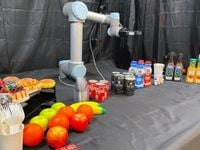Robotic systems are increasingly becoming integral to our daily lives, yet their ability to understand and assist humans has often lagged behind expectations. Researchers at the Massachusetts Institute of Technology (MIT) have made significant strides in bridging this gap with a novel approach dubbed "Relevance." This new framework enables robots to focus on the most pertinent features in their environment, allowing them to assist humans in a more seamless, intelligent, and safe manner.
The Relevance approach is designed to help robots interpret audio and visual cues to ascertain a human's objective and quickly identify objects that are most likely to fulfill that objective. This innovative method was put to the test in a simulated conference breakfast buffet, where a robotic arm was tasked with assisting humans navigating a table laden with various fruits, drinks, snacks, and tableware.
In the experiment, the robot demonstrated an impressive ability to predict a human's objective with 90% accuracy and identify relevant objects with 96% accuracy. Notably, the implementation of this method significantly enhanced the robot's safety, reducing the number of collisions by more than 60% compared to traditional methods.
"This approach of enabling relevance could make it much easier for a robot to interact with humans," said Kamal Youcef-Toumi, a professor of mechanical engineering at MIT. He emphasized that robots equipped with this technology would not need to ask numerous questions to determine what humans require. Instead, they can actively gather information from their surroundings to provide assistance.
The Relevance framework draws inspiration from the human brain's Reticular Activating System (RAS), a network of neurons responsible for filtering out unnecessary stimuli, allowing individuals to focus on what is important at any given moment. Youcef-Toumi explained, "The amazing thing is, these groups of neurons filter everything that is not important, and then it has the brain focus on what is relevant at the time. That’s basically what our proposition is."
The robotic system mimics the RAS's ability to selectively process and filter information through four main phases: perception, trigger check, relevance determination, and object offering. During the perception stage, the robot captures audio and visual cues, which are continuously fed into an AI toolkit. This toolkit includes a large language model (LLM) that processes conversations to identify keywords and phrases, as well as algorithms that detect and classify objects, humans, physical actions, and task objectives.
The second stage, known as the trigger check, involves periodic assessments to determine if a human is present. Once a human is detected, the relevance determination phase kicks in, where the system identifies features in the environment most likely relevant to assist the human. For example, if the LLM detects the keyword "coffee" and observes a person reaching for a cup, the system will prioritize relevant items like creamers and stirrers over unrelated objects.
In the final phase, the robot plans a path to physically access and offer the identified relevant objects to the human. This was effectively demonstrated in the breakfast buffet scenario, where the robot was able to assist individuals based on their actions and conversations. For instance, when a human reached for a can of coffee, the robot promptly handed over milk and a stir stick.
First author Xiaotong Zhang expressed enthusiasm for the potential applications of the Relevance system. "I would want to test this system in my home to see, for instance, if I'm reading the paper, maybe it can bring me coffee. If I'm doing laundry, it can bring me a laundry pod. If I'm doing repair, it can bring me a screwdriver. Our vision is to enable human-robot interactions that can be much more natural and fluent," Zhang said.
The research team is now exploring how robots programmed with Relevance can enhance productivity in smart manufacturing and warehouse environments. The ability to anticipate human needs and offer assistance without explicit requests could revolutionize how we interact with machines in various settings.
The work is set to be presented at the IEEE International Conference on Robotics and Automation (ICRA 2025) in May, showcasing the potential of this innovative approach to robotic assistance. The research builds on previous studies and aims to expand the capabilities of robots in dynamically changing environments.
As technology continues to evolve, the Relevance approach represents a significant leap forward in the development of intelligent robotic systems that can improve human productivity and safety. By enabling robots to focus on what truly matters in a given context, this research paves the way for more intuitive and effective human-robot collaboration.
For those interested in further details, the research paper is available on the arXiv preprint server under the title "Relevance-driven Decision Making for Safer and More Efficient Human Robot Collaboration." The DOI for this work is 10.48550/arxiv.2409.13998.

